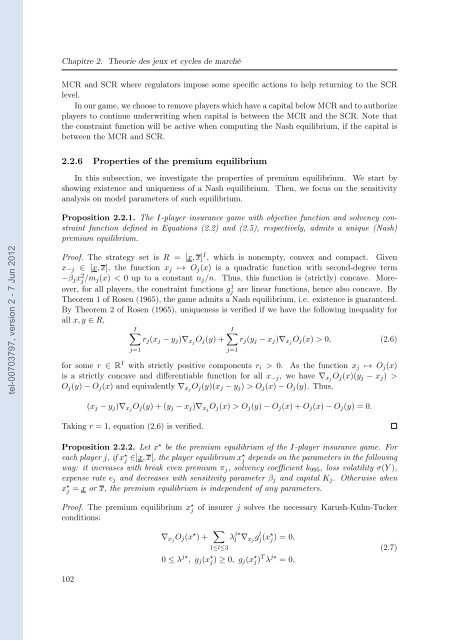Etude des marchés d'assurance non-vie à l'aide d'équilibres de ...
Etude des marchés d'assurance non-vie à l'aide d'équilibres de ...
Etude des marchés d'assurance non-vie à l'aide d'équilibres de ...
You also want an ePaper? Increase the reach of your titles
YUMPU automatically turns print PDFs into web optimized ePapers that Google loves.
tel-00703797, version 2 - 7 Jun 2012<br />
Chapitre 2. Theorie <strong><strong>de</strong>s</strong> jeux et cycles <strong>de</strong> marché<br />
MCR and SCR where regulators impose some specific actions to help returning to the SCR<br />
level.<br />
In our game, we choose to remove players which have a capital below MCR and to authorize<br />
players to continue un<strong>de</strong>rwriting when capital is between the MCR and the SCR. Note that<br />
the constraint function will be active when computing the Nash equilibrium, if the capital is<br />
between the MCR and SCR.<br />
2.2.6 Properties of the premium equilibrium<br />
In this subsection, we investigate the properties of premium equilibrium. We start by<br />
showing existence and uniqueness of a Nash equilibrium. Then, we focus on the sensitivity<br />
analysis on mo<strong>de</strong>l parameters of such equilibrium.<br />
Proposition 2.2.1. The I-player insurance game with objective function and solvency constraint<br />
function <strong>de</strong>fined in Equations (2.2) and (2.5), respectively, admits a unique (Nash)<br />
premium equilibrium.<br />
Proof. The strategy set is R = [x, x] I , which is <strong>non</strong>empty, convex and compact. Given<br />
x−j ∈ [x, x], the function xj ↦→ Oj(x) is a quadratic function with second-<strong>de</strong>gree term<br />
−βjx2 j /mj(x) < 0 up to a constant nj/n. Thus, this function is (strictly) concave. Moreover,<br />
for all players, the constraint functions g1 j are linear functions, hence also concave. By<br />
Theorem 1 of Rosen (1965), the game admits a Nash equilibrium, i.e. existence is guaranteed.<br />
By Theorem 2 of Rosen (1965), uniqueness is verified if we have the following inequality for<br />
all x, y ∈ R,<br />
I<br />
rj(xj − yj)∇xj Oj(y)<br />
I<br />
+ rj(yj − xj)∇xj Oj(x) > 0, (2.6)<br />
j=1<br />
j=1<br />
for some r ∈ R I with strictly positive components ri > 0. As the function xj ↦→ Oj(x)<br />
is a strictly concave and differentiable function for all x−j, we have ∇xj Oj(x)(yj − xj) ><br />
Oj(y) − Oj(x) and equivalently ∇xj Oj(y)(xj − yj) > Oj(x) − Oj(y). Thus,<br />
(xj − yj)∇xj Oj(y) + (yj − xj)∇xj Oj(x) > Oj(y) − Oj(x) + Oj(x) − Oj(y) = 0.<br />
Taking r = 1, equation (2.6) is verified.<br />
Proposition 2.2.2. Let x⋆ be the premium equilibrium of the I-player insurance game. For<br />
each player j, if x⋆ j ∈]x, x[, the player equilibrium x⋆j <strong>de</strong>pends on the parameters in the following<br />
way: it increases with break even premium πj, solvency coefficient k995, loss volatility σ(Y ),<br />
expense rate ej and <strong>de</strong>creases with sensitivity parameter βj and capital Kj. Otherwise when<br />
x⋆ j = x or x, the premium equilibrium is in<strong>de</strong>pen<strong>de</strong>nt of any parameters.<br />
Proof. The premium equilibrium x ⋆ j<br />
conditions:<br />
102<br />
∇xj Oj(x ⋆ ) + <br />
of insurer j solves the necessary Karush-Kuhn-Tucker<br />
1≤l≤3<br />
λ j⋆<br />
l ∇xj gl j(x ⋆ j) = 0,<br />
0 ≤ λ j⋆ , gj(x ⋆ j) ≥ 0, gj(x ⋆ j) T λ j⋆ = 0,<br />
(2.7)
















